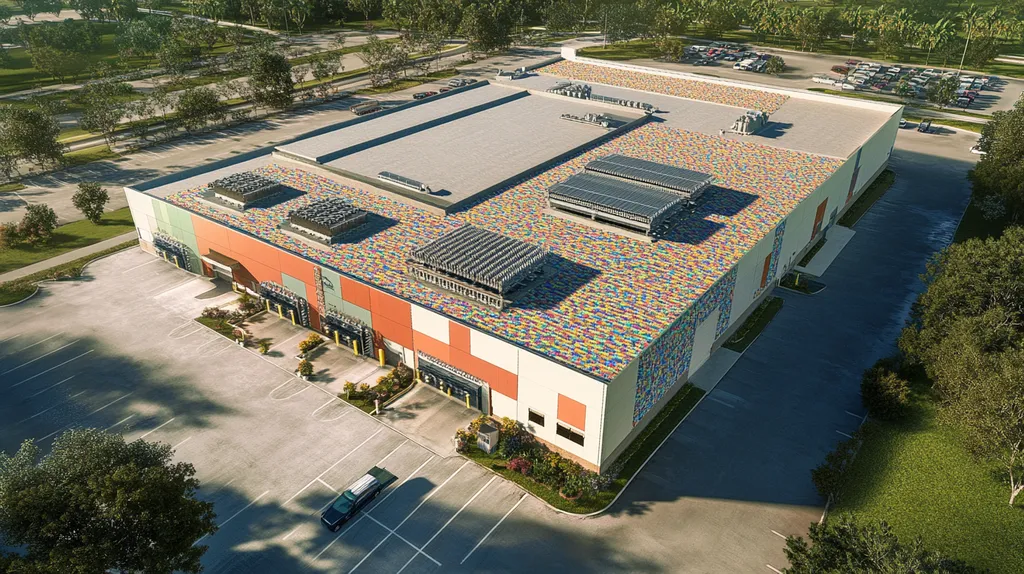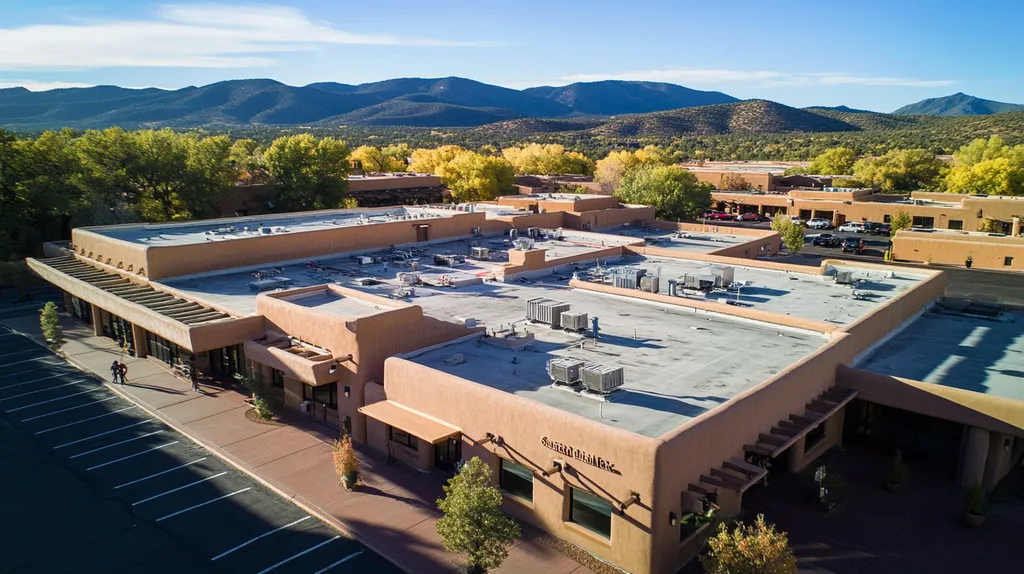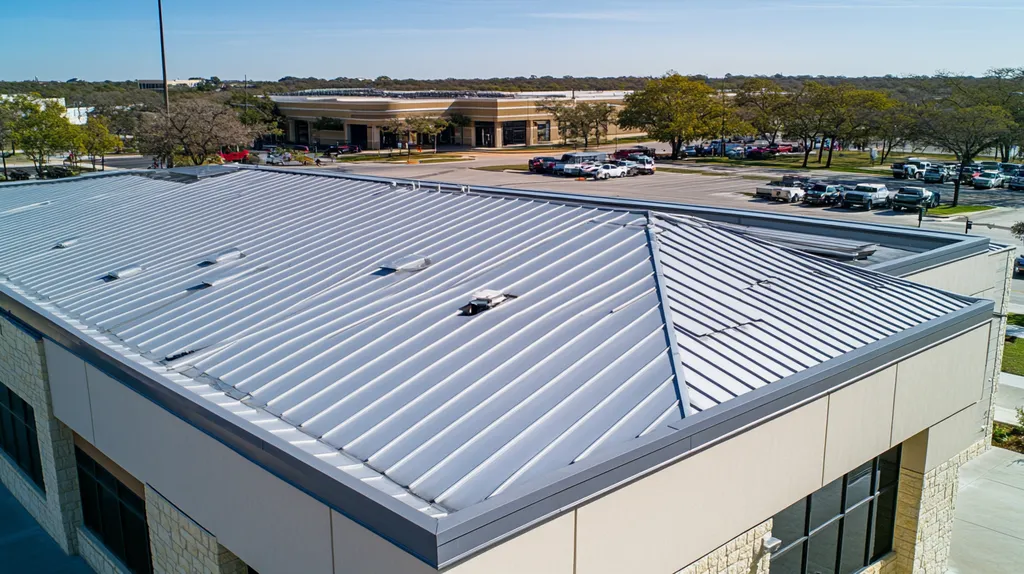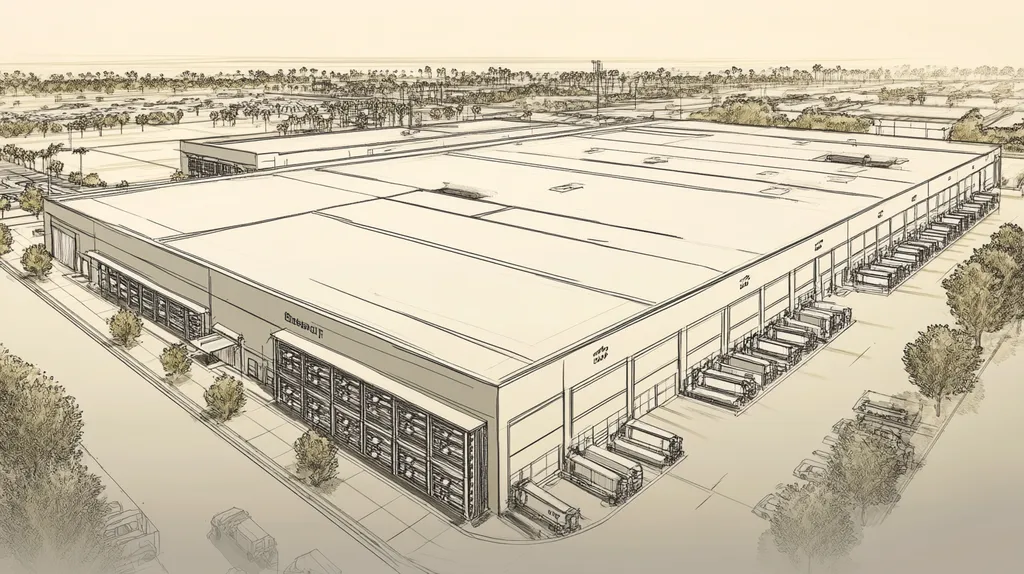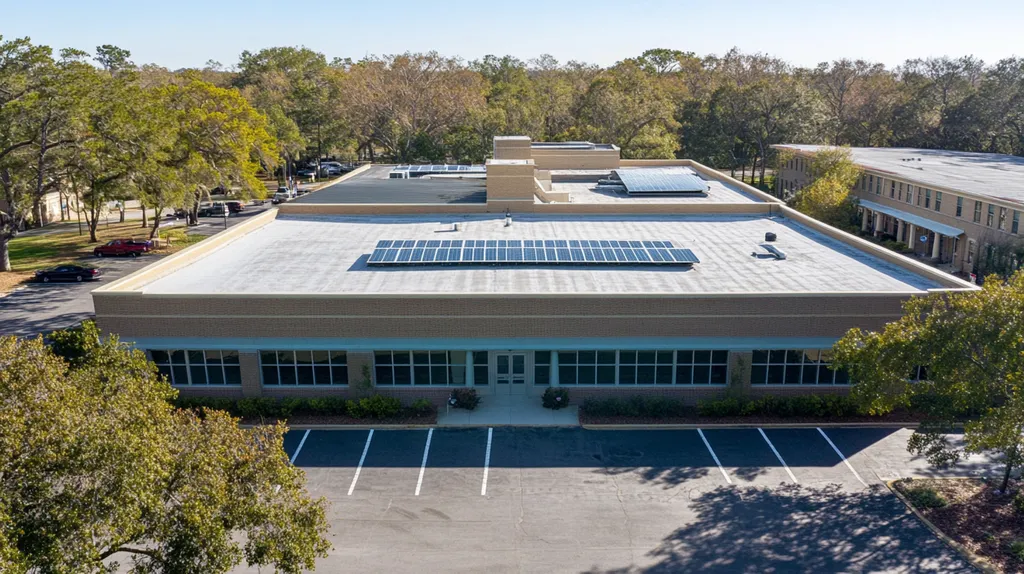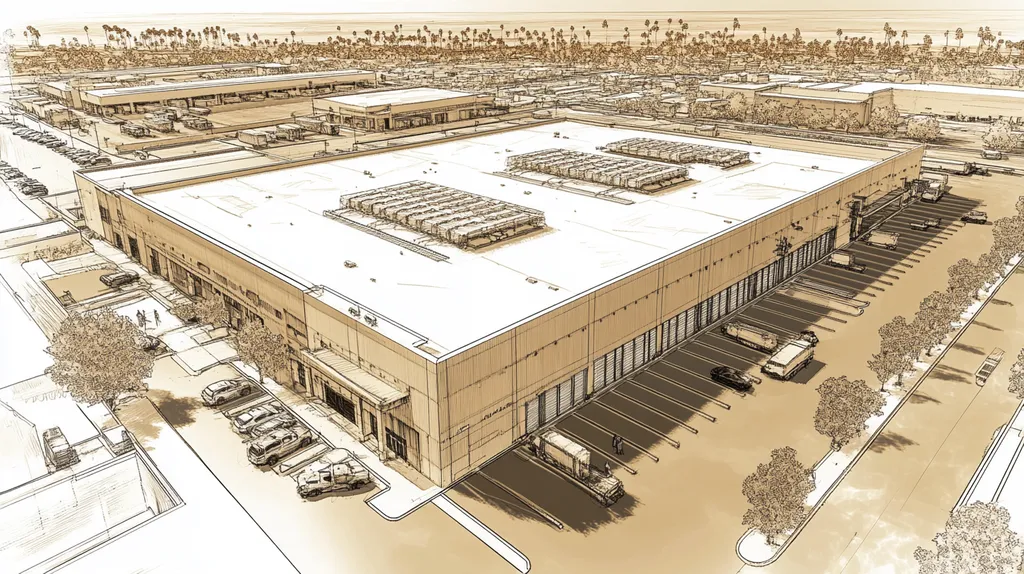With over 60% of commercial roofs failing prematurely due to improper coating selection, property managers can’t afford to make uninformed decisions about roof protection. The wrong choice can lead to extensive damage, soaring energy costs, and expensive repairs.
Understanding the differences between coating options – from reflective acrylics to moisture-resistant silicones – is crucial for maximizing roof performance and longevity.
This comprehensive guide breaks down the essential factors in selecting commercial roof coatings, helping facility managers navigate technical specifications, performance metrics, and cost considerations with confidence.
SECTION 1: THE BASICS EXPLAINED
For property managers, understanding roof coatings is essential for safeguarding buildings against costly repairs and early replacements. Shockingly, over 60% of commercial roofing systems fail within just two decades. Choosing the right coating can not only prolong the lifespan of your roof but also result in significant cost savings for your facility. In this section, we will break down what roof coatings are, why they are vital for your building, and the mechanics of how they work.
What It Is (In Plain Language)
Roof coatings are like protective armor for your existing roofing materials. They form a strong barrier against harsh weather and damaging UV rays, helping to keep the underlying roof intact. Available in different types such as liquid-applied coatings and membrane systems, each option is tailored for specific roofing needs.
These coatings come from materials like acrylic, silicone, or polyurethane, chosen for their unique properties such as flexibility and durability. By providing a smooth, seamless layer, roof coatings eliminate vulnerabilities like cracks and seams that can lead to leaks.
Instead of viewing these coatings as replacements, property managers should see them as smart upgrades that extend the roof’s life without the hefty price tag of a complete roof overhaul.
In short, roof coatings are a critical enhancement that fortifies existing roofing systems and helps maximize their utility.
Why It Matters (To Your Building)
The type of roof coating you choose can drastically affect your building’s health and energy efficiency. A properly selected coating acts as a shield against leaks, manages heat retention, and may even elevate insulation values.
In fact, studies indicate that reflective coatings can lower cooling expenses by up to 30%, a game-changer as energy costs rise and eco-friendly regulations tighten.
Additionally, maintaining a roof without severe damage helps property managers dodge expensive repairs and replacements. A longer-lasting roof not only conserves resources but also frees up funds for other critical areas.
Therefore, opting for the right roof coating is much more than mere maintenance; it’s a strategic investment in the durability and efficiency of your entire property.
How It Works
Roof coatings operate through a blend of adhesion and pliability. Once applied, they adhere firmly to the existing roof, forming a protective seal that guards against moisture and environmental wear.
For instance, acrylic coatings provide a sleek surface that reflects solar heat, while silicone coatings are exceptionally effective against water intrusion. This diversity allows property managers to select coatings that best suit their climate and environmental conditions.
Beyond straightforward benefits, roof coatings also promote sustainability. By minimizing heat absorption, they help reduce the urban heat island effect and improve overall energy consumption.
Ultimately, grasping the mechanics of roof coatings empowers property managers to make well-informed decisions, ensuring that resources are allocated for optimal roofing performance.
SECTION 2: PRACTICAL APPLICATIONS
For property managers, recognizing the practical applications of roof coatings is crucial. With commercial roofs constantly under the stress of harsh weather conditions, the right coating has the potential to significantly extend their lifespan and boost energy efficiency. For example, reflective coatings can lower cooling costs by as much as 30%, offering immediate financial relief alongside long-term savings. This section will delve into common uses of roof coatings, highlight key situations when they are most beneficial, and discuss how they interact with other roofing systems.
Common Uses & Examples
Roof coatings are becoming increasingly essential in the world of commercial roofing. They are often applied to flat roofs to improve waterproofing and enhance energy efficiency. A standout example is the use of elastomeric coatings on single-ply membrane roofs, which not only maintain flexibility but also shield against harmful UV rays.
Metal roofs also experience significant advantages from coatings that prevent corrosion and extend their lifespan. A reflective coating can cleverly transform a hot, dark metal roof into a cool, energy-saving asset, making a tangible difference in energy costs.
Built-up roofs receive the same attention, as coatings serve as a protective barrier, diminishing wear and tear from environmental elements. By providing a seamless finish, these coatings help prevent leaks and reduce the risk of future damage.
Ultimately, the versatility of roof coatings fills performance and longevity gaps across various roofing types, proving to be a wise choice for property managers.
When You Need It Most
Timing plays a critical role when deciding to apply roof coatings. Often, the need arises during routine inspections or in the aftermath of severe weather events. If a roof exhibits distress signs like surface cracks or blistering, applying a coating can serve as an immediate remedy to halt further damage.
Older roofs, especially those nearing the end of their life expectancy, are prime candidates for coating applications. This approach can be considerably more budget-friendly than a complete roof replacement, while still extending functionality.
Additionally, for buildings located in regions that experience extreme temperatures, coatings provide essential thermal protection. Property managers in these climates should prioritize coating applications to enhance longevity and keep utility costs in check.
In summary, understanding the timing for coating application is vital for maximizing a roof’s lifespan and operational efficiency.
Interactions With Other Systems
The compatibility of roof coatings with existing systems is essential for optimal application. Some coatings may have negative interactions with certain materials, leading to diminished effectiveness. For example, when a coating is applied over incompatible substrates, it can result in adhesion failure, which undermines the waterproofing capability.
When integrating coatings with other roofing elements, such as insulation or drainage systems, considering both compatibility and overall design is vital. A reflective coating applied to a well-designed drainage system can significantly enhance performance by decreasing thermal stress.
Moreover, property managers must review existing warranties before proceeding with any coating application. Some manufacturers may void warranty claims if incompatible coatings are utilized. Therefore, verifying compatibility is a critical step in the planning process.
In the end, ensuring harmonious interactions between roof coatings and existing systems can lead to improved building performance and substantial cost savings over time.
SECTION 3: KEY TERMINOLOGY DECODED
Navigating the world of roof coatings can feel overwhelming, especially with the flood of technical terms that can obscure your understanding. For property managers, grasping these terms is vital to making informed and cost-effective decisions. Improper choices can lead to expensive repairs, wasted resources, and compromised roof integrity. By breaking down the language of roofing, property managers can confidently assess their options and implement the best solutions for their buildings.
Essential Terms Explained
One key term often encountered in roof coating discussions is “elastomeric.” This term refers to a coating that possesses flexibility, enabling it to expand and contract with changing temperatures. In areas facing significant temperature swings, elastomeric coatings offer crucial protection against cracks and other damage.
Another important term is “reflectivity.” This describes a coating’s capacity to bounce sunlight and heat away from a building. A higher reflectivity rating can lead to substantial energy savings, especially for commercial properties situated in sunny climates, making this metric an essential consideration.
Next is “adhesion,” which measures how well a coating bonds to the roof surface. Strong adhesion is critical because poor bonding can cause the coating to fail sooner than expected. Recognizing this term assists in determining the quality of a product.
Lastly, “tightness” refers to a roof’s effectiveness in preventing water from leaking in. Coatings that ensure tightness act as a formidable barrier against water intrusion during severe weather, protecting the building and its contents.
Industry Jargon Translated
Dismantling industry jargon is essential for clear communication. For example, “SRI,” or Solar Reflective Index, may sound technical but plays a critical role in energy efficiency. The SRI measures a surface’s ability to reflect solar energy, and higher numbers equate to enhanced performance under the sun.
“Life Cycle Cost” (LCC) is another significant term: it encompasses the overall cost of a roofing system throughout its life span. This includes initial installation, maintenance, and any potential repair costs, providing a complete financial overview for informed decision-making.
The term “VOC” stands for Volatile Organic Compounds. Many coatings contain VOCs, which can adversely impact indoor air quality. Therefore, opting for low-VOC products can improve indoor environments while still delivering effective roofing solutions.
By understanding these terms, property managers empower themselves to demand better products and make smarter purchasing choices, transforming a complicated topic into digestible information.
Measurement & Units Simplified
Measurements are essential when evaluating and comparing different roof coatings. “Dry Film Thickness” (DFT) is a crucial metric that indicates how thick the coating is once it has dried. Generally, a greater DFT is associated with enhanced performance and longevity.
Another key measurement is “Square Foot Coverage,” which tells you how much area a gallon of coating will cover. This knowledge is invaluable for property managers when estimating costs and planning materials needed for a project.
Additionally, “Watt per Square Meter” measures a roof’s heat absorption capabilities, giving you insights into energy performance across various climates. Familiarity with these measurements can streamline the decision-making process.
By mastering these measurement units, property managers can effectively compare products and identify which options deliver the best value and performance tailored to their specific roofing needs.
SECTION 4: DECISION FACTORS
Selecting the right roof coating for a commercial property is a crucial decision with lasting financial and operational implications. Property managers must carefully evaluate factors such as cost, performance, and durability to avoid costly missteps. With the stakes so high, overlooking these areas could lead to premature roof failures that negatively impact expenses, tenant satisfaction, and even safety. Understanding these decision factors empowers managers to make choices that protect their investments and serve their properties well.
Cost Considerations
Cost is frequently the first consideration for property managers when selecting a roof coating. While the initial investment may seem attractive, it is vital to understand the long-term financial implications involved. For instance, opting for cheaper coatings can result in more frequent applications, driving up lifetime expenses despite lower upfront costs.
Labor costs should also be included in the overall budget when estimating total expenses. High-quality coatings often require skilled application, which can increase initial costs. However, this expenditure may lead to a longer-lasting coating and reduced maintenance needs over time.
Moreover, property managers should factor in potential energy savings. Certain coatings have reflective properties that reduce energy demand and lower HVAC costs. Over time, these savings can offset the investment, making high-performance coatings a more economical choice in the long run.
Ultimately, it’s essential to weigh initial costs against potential long-term savings. A thorough financial analysis allows property managers to make well-informed decisions, ensuring lasting value and stability for their roofing systems.
Performance Trade-offs
Performance levels can vary significantly between different roof coating options. Understanding these differences helps property managers choose a coating that aligns with their specific building requirements. For example, while acrylic coatings are known for being budget-friendly and easy to apply, they may not offer the same durability as silicone coatings, which excel at resisting moisture.
Environmental factors are also critical in determining performance. Properties located in areas vulnerable to harsh weather, like heavy rain or intense UV exposure, may require specialized coatings for optimal protection. Choosing an unsuitable product could lead to premature failures and expensive repairs.
Warranties associated with different coatings are another essential consideration. Manufacturers often back their products based on specific performance metrics. A longer warranty period can serve as an indicator of reliability and superior performance in challenging conditions.
In summary, weighing performance trade-offs is vital. Property managers should assess their unique building needs, local climate, and potential exposure to ensure they select the best option for their roofs.
Lifespan & Durability Factors
The expected lifespan and durability of roof coatings can vary considerably, making them crucial factors for long-term planning. Coatings often come with warranties ranging from 5 to 20 years, but real-world performance can differ due to various influences. Routine maintenance, environmental factors, and proper application play significant roles in determining how long a coating will last.
When assessing durability, it’s important to consider the specific materials used. For instance, silicone coatings are renowned for their spectacular resistance to UV degradation and standing water, making them particularly suited for flat roofs. Conversely, some types of acrylic coatings may experience more wear in similar situations.
Regular maintenance can also prolong the lifespan of a roof coating. Buildings that invest in scheduled inspections and maintenance typically enjoy the rewards of their investments longer. Implementing a proactive maintenance strategy can help spot issues early, preserving both roofing performance and the overall value of the investment.
In conclusion, understanding lifespan and durability factors is essential for making informed decisions. By selecting the right coating and committing to rigorous upkeep, property managers can ensure that their roofs remain reliable for years to come.
SECTION 5: COMMON CHALLENGES
Selecting the right roof coating is vital for property managers, as they face a variety of challenges that can jeopardize the roof’s performance and lifespan. Issues like poor adhesion, UV degradation, and moisture infiltration can compromise a roof’s integrity and lead to costly repairs. Understanding these challenges enables property owners to make informed choices, safeguarding their investments while ensuring the longevity of their roofs.
Frequent Problems & Solutions
A significant challenge in roof coatings is inadequate surface preparation. If a roof isn’t properly cleaned and primed, coatings may fail to bond effectively, resulting in delamination or peeling. Property owners must ensure that surfaces are clear of debris, oils, and moisture to secure a strong foundation for the coating.
Another common issue is UV degradation, which can degrade coatings over time. To combat this, facility managers should choose UV-resistant coatings tailored to their environment. Regular inspections help in detecting early signs of deterioration before they escalate into major problems.
Water infiltration presents a serious threat, capable of causing extensive structural damage. To prevent this, it’s essential to select coatings with robust waterproofing features. Additionally, strengthening areas prone to water pooling can mitigate issues. An effective drainage system plays a crucial role in safeguarding against water-related risks.
Lastly, being unaware of warranty terms can lead to disputes and unexpected costs. Property owners should read the warranty guidelines thoroughly to understand what is covered and avoid surprises down the line.
Warning Signs To Watch For
Early identification of warning signs can save significant resources for property managers. One critical sign is bubbling or blistering of the coating, indicating moisture trapped beneath the surface. Immediate investigation is essential to uncover any underlying issues.
Another sign to stay vigilant for is discoloration or fading, which could mean that the UV protective properties of the coating are diminishing. Conducting routine inspections can help catch these issues early and prevent further damage.
Crumbling or cracking around seams or edges may pose substantial risks for leaks and moisture entry. Keeping a close eye on these areas can help avert moisture-related complications that threaten the overall integrity of the roof.
Finally, visible water pooling post-rainstorm suggests inadequate drainage, which might necessitate reevaluation of the coating or drainage system. Addressing these concerns promptly is vital for preserving roof integrity.
Preventative Approaches
Implementing proactive measures can greatly extend the lifespan of commercial roof coatings. Regular inspections should take place at least twice a year, ideally in spring and fall, to pinpoint potential issues before they spiral out of control. Inspectors should look for signs of wear, environmental damage, and any other areas of concern.
A solid maintenance plan is crucial. This may include periodic re-coating to refresh protective layers and boost performance. Property managers who prioritize maintenance are likely to see a more favorable return on their investment, coupled with fewer unanticipated repair costs.
Investing in high-quality materials tailored to local climate conditions is essential for optimal roofing performance. While cheaper options might seem appealing initially, they can result in higher long-term expenses due to increased maintenance needs.
Lastly, collaborating with professional roofing contractors who understand industry standards ensures that chosen solutions meet the required quality benchmarks. Skilled professionals can accurately assess specific needs and recommend the most effective roofing strategies.
SECTION 6: NEXT STEPS & RESOURCES
Choosing the right roof coating is not just about aesthetics; it’s a critical decision that can impact long-term performance and safeguard your building’s integrity. With over 50% of commercial roofs exceeding their expected lifespan, property managers can’t afford to lack vital knowledge. A wrong choice could lead to costly repairs and potential safety hazards. This section will guide you through essential questions to ask providers, key industry standards to be aware of, and resources for continued learning.
Questions To Ask Providers
When engaging roofing providers, the right questions can make all the difference. Property managers should first ask about the specific performance characteristics of each coating, focusing on attributes like UV resistance, thermal reflectivity, and the flexibility of materials in changing temperatures.
It’s equally important to dig into warranty details. Warranty terms can vary widely, so knowing what coverage each coating offers protects your investment for the future.
Understanding the installation process is also crucial. Improper application can void warranties and shorten the lifespan of the coating. Reputable providers will gladly share their application methods and the certifications their teams hold.
Lastly, asking for references or examples of past projects can reveal a provider’s reliability and success rates. This insight can provide reassurance as you navigate your decision-making journey.
Industry Standards & Guidelines
Being aware of industry standards is vital for choosing high-quality roofing materials. Organizations like the ASTM (American Society for Testing and Materials) and the NRCA (National Roofing Contractors Association) publish guidelines that detail performance tests and best practices for roof coatings.
Familiarity with these standards allows property managers to select products that have undergone rigorous assessments. For instance, ASTM guidelines cover adhesion strength, rainfall resistance, and UV exposure resilience, which are integral to performance expectations.
Additionally, understanding certifications like Energy Star and LEED can guide you towards sustainable choices that may also offer tax incentives. These certifications contribute positively to both your budget and environmental efforts.
Regularly reviewing updated standards ensures compliance in today’s rapidly changing roofing landscape. Making it a routine practice will help you stay informed and confident in your choices.
Further Learning Simplified
To stay informed about roof coating options, property managers have a variety of resources at their disposal. Online platforms offer courses and webinars that focus specifically on the latest roofing technologies and best practices. Organizations like the NRCA produce valuable materials designed to keep stakeholders knowledgeable.
Networking at trade conferences or local seminars can also enhance understanding. Engaging with peers provides valuable insights into product performance and the reliability of different providers.
Subscribing to roofing industry journals can be another beneficial move. These publications often feature case studies, product evaluations, and expert opinions that can aid in your decision-making process.
Finally, consulting with roofing specialists can deliver tailored advice geared specifically towards your property’s unique needs. Professional evaluations can uncover options that might not be apparent during independent research.
The Bottom Line
With over $3.3 billion spent annually on premature roof replacements due to coating failures, property managers must leverage available resources to make informed decisions about their roofing systems.
Industry databases, manufacturer specifications, and professional associations provide critical data for comparing coating performance across different environmental conditions and substrates.
Technical bulletins from organizations like NRCA and ASTM offer standardized testing results that enable objective comparisons of durability, adhesion strength, and weather resistance between coating options.
By utilizing these resources to evaluate coating choices against facility-specific needs, property managers can select solutions that maximize roof longevity while optimizing their maintenance budgets.
The stakes are simply too high to make uninformed decisions about commercial roof protection.
FREQUENTLY ASKED QUESTIONS
Q. What is a commercial roof coating?
A. A commercial roof coating acts like protective armor for your roof. It enhances durability by forming a barrier against weather elements, ensuring your existing roofing is maintained and extended in life.
Q. How can a commercial roof coating save money?
A. Applying a roof coating can significantly reduce energy expenses by improving insulation. Moreover, it helps avoid costly repairs or early replacements, making it a strategic long-term investment for property managers.
Q. When is it best to apply a coating to my industrial roof?
A. The best time to apply a coating is during routine inspections or after noticing damage signs. Older roofs or those dealing with extreme weather should be prioritized for coating applications.
Q. What are the important terms related to commercial roof coatings?
A. Essential terms include “elastomeric” for flexibility, “reflectivity” for energy savings, and “adhesion” for bonding quality. Understanding these terms helps you gauge the performance of coatings better.
Q. How does cost influence roof coating decisions for commercial roofs?
A. While initial costs are significant, it’s crucial to consider long-term expenses. Cheaper options may require more frequent applications, leading to higher lifetime costs than quality solutions.
Q. What challenges might I face with industrial roof coatings?
A. Challenges include inadequate surface preparation, UV degradation, and water infiltration. These issues can compromise performance, making it important to choose the right coating and apply it correctly.
Q. What next steps should I take for my roof coating needs?
A. Engage with reputable roofing providers by asking specific questions about performance, warranties, and application. Familiarize yourself with industry standards and consider ongoing education through online platforms.

